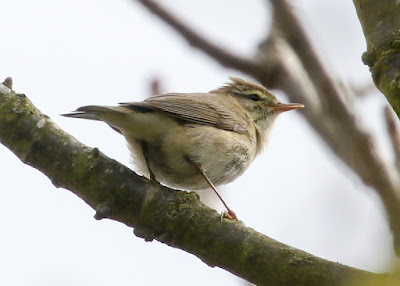Having enjoyed the sight of a single male ring ouzel in a field near the East Mersea Golfhouse on Wednesday 12th, there was double the excitement the next day when another ring ouzel was found alongside the first one.
The first bird was found by Martin Cock and Andrew Tilsey as they walked along the seawall. Then early on Thursday morning Angela Buckley doubled the ring ouzel count with the discovery of a second bird. At times the birds fed close to the seawall where good views were provided, such as this one pictured above on Thursday afternoon.
On the first day the ring ouzel spent most of the time at the back of the field, where these two photos were taken by Andy Field. This is the third spring in the row a ring ouzel has been found at this end of the island. The ring ouzels are stopping off on their migration from north Africa where they've spent the winter, to their breeding grounds on the mountain tops of the UK and Scandinavia.

As well as the
ring ouzels in the field, a
redwing was present on both Wednesday and Thursday, as well as 4
song thrushes and 5
blackbirds. Also on Wednesday 70
linnets were in the Golfhouse horse paddock, also 4
avocets,
snipe and a
whimbrel on the saltmarsh, while a
common tern was in the Colne. A
common whitethroat was found on Wednesday by Martin and Andrew further along the seawall towards the Oyster Fishery and they also noted 4
common scoter and 4
common terns in the Colne.
On Thursday a
mallard was keeping a close eye on her new brood of ten small ducklings in the dyke by the Golfhouse.
There was a variety of waders roosting on the Golfhouse saltmarsh pools during the Thursday high tide with 3+
knot, 150+
dunlin, 20+
turnstone, 50+
redshank,
black-tailed godwit and two
avocets.

A pair of avocets dropped onto the main pool in the park grazing fields on Tuesday 11th.
The first swallow at the park this spring was seen flying over the fields on Tuesday evening. Two wigeon, 4 shoveler and a pair of kestrels were also noted here while on the park a sparrowhawk flashed past, a willow warbler singing, 3 blackcaps and 3 chiffchaffs also singing. Four Mediterranean gulls flew over the park calling.

On Wednesday at the park pond, a pair of swans appeared to be thinking about nest-building until they were given their marching orders by the resident pair of swans. The beaks on the "foreign" pair appeared to be duller pink in colour, suggesting young-adult birds trying their luck here.
Also at the pond on Wednesday were 14 tufted ducks which increased to 18 the next day along with 8 pochard. Two swallows flew over the pond and fields on both Wednesday and Thursday.
On the park's grazing fields on Thursday 72 black-tailed godwits were roosting late afternoon on the main pool.
A corn bunting was singing from the overhead wires by Chapmans Lane near West Mersea on Tuesday morning. A swallow was flying near Haycocks Stables on Thursday.
Two grey partridge were seen in a field near Home Farm, East Mersea on Sunday 9th by Martin Cock. A willow warbler was singing in Firs Chase, West Mersea on Friday 7th.
The recent sunny weather has brought a few more butterflies onto the wing with four
speckled woods seen at the park on Thursday 13th. Also
orange-tip, comma, small tortoiseshell, peacock and
green-veined white.
An
adder was seen at the park on Wednesday 12th.
The clear skies at night have been poor for moths at the park although this nut-tree tussock pictured above, is the first spring sighting here. It has become more regular in recent summers and now it seems it has managed an early generation this year.
The first Chinese character is a regular both in the spring and summer, although this individual is probably a month earlier than usual here.
The V-pug is a regular especially in the summer although this individual is a first one for the early spring. Only twenty moths were found during Wednesday night - although much better than just the five recorded on Tuesday night. The two other species making up the numbers have been common quaker and Hebrew character.
A muntjac deer was barking loudly and continuously for half an hour on Tuesday evening from the back of the park pond.
A female muntjac with a young fawn was seen last week by Teresa Parkin in her back garden near Meeting Lane. Also last week a red squirrel was seen in the garden of the Golfhouse by Graham Gurton.



























































